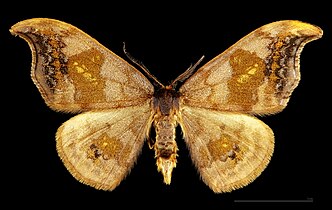| Sabra harpagula | |
|---|---|
 | |
| Scientific classification | |
| Domain: | Eukaryota |
| Kingdom: | Animalia |
| Phylum: | Arthropoda |
| Class: | Insecta |
| Order: | Lepidoptera |
| Family: | Drepanidae |
| Genus: | Sabra |
| Species: | S. harpagula |
| Binomial name | |
| Sabra harpagula | |
| Synonyms | |
| |
Sabra harpagula, the scarce hook-tip, is a moth of the family Drepanidae first described by Eugenius Johann Christoph Esper in 1786. It is found from Europe through temperate Asia to Japan.
Contents
The wingspan is 25–35 mm. The moth flies from June to August depending on the location.
- ♂
- ♂ △
The larvae feed on Tilia (including Tilia cordata ), Quercus , Alnus and Betula species.

